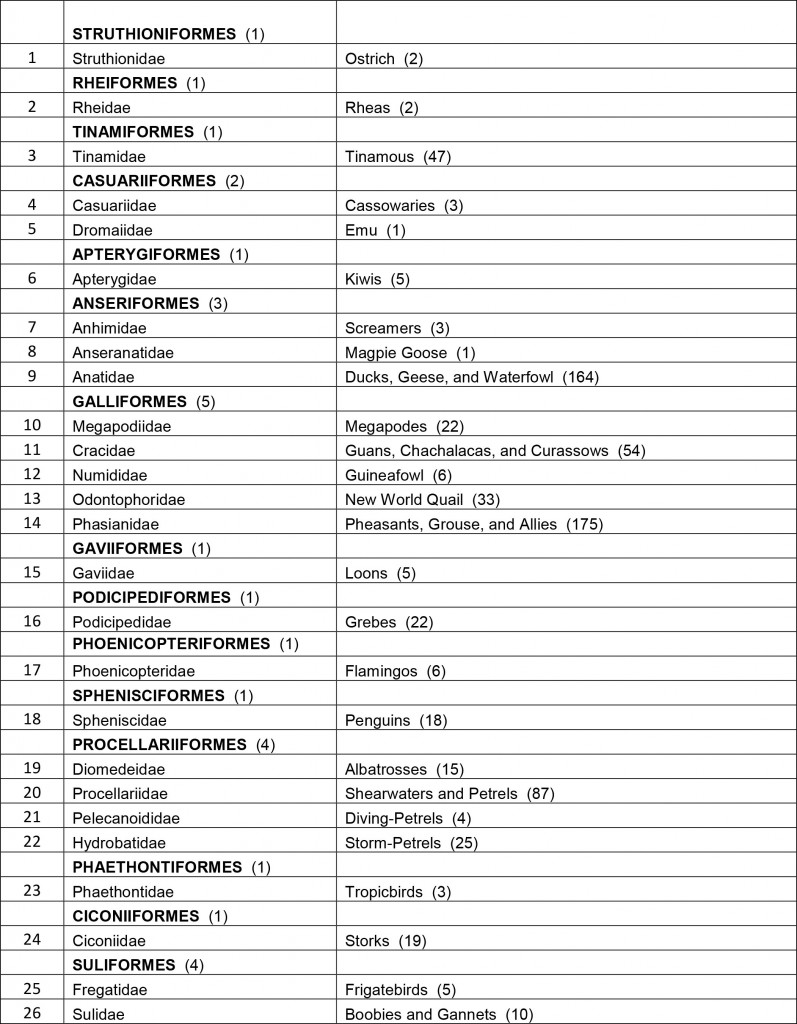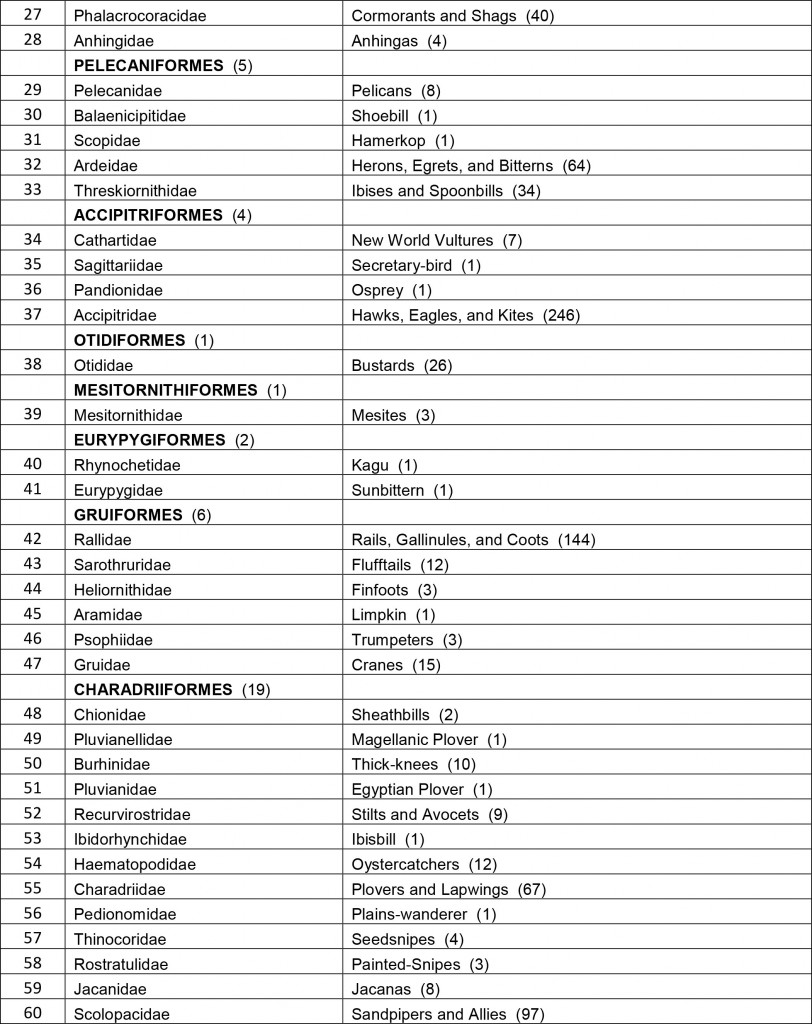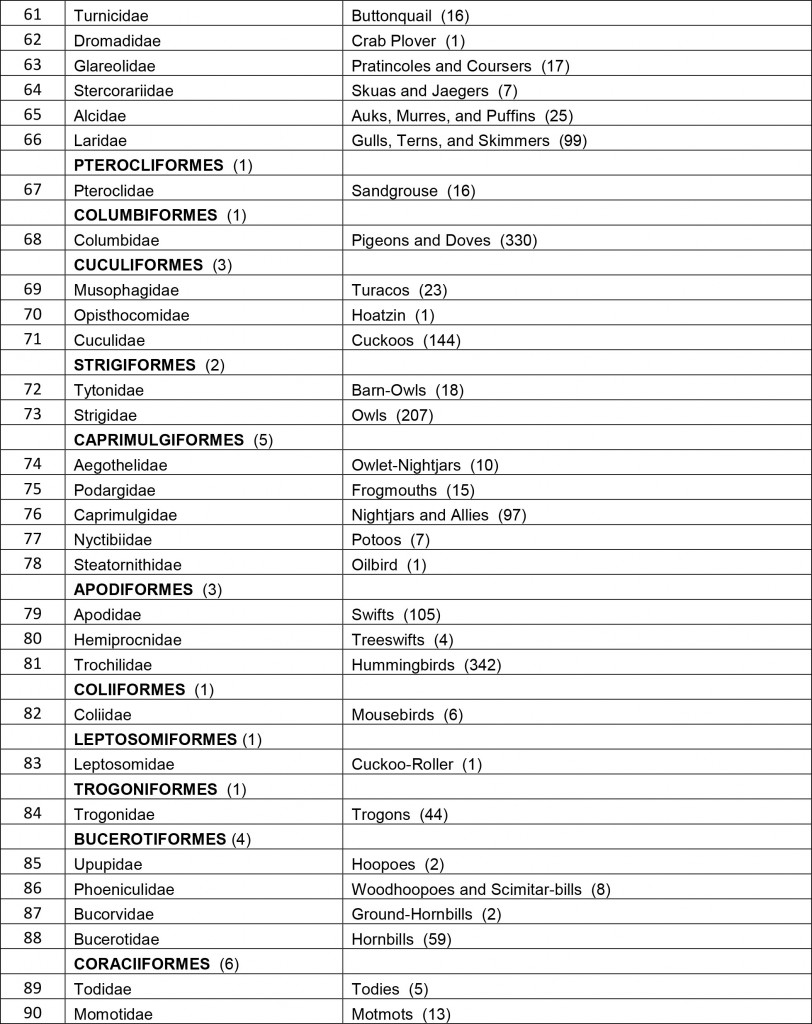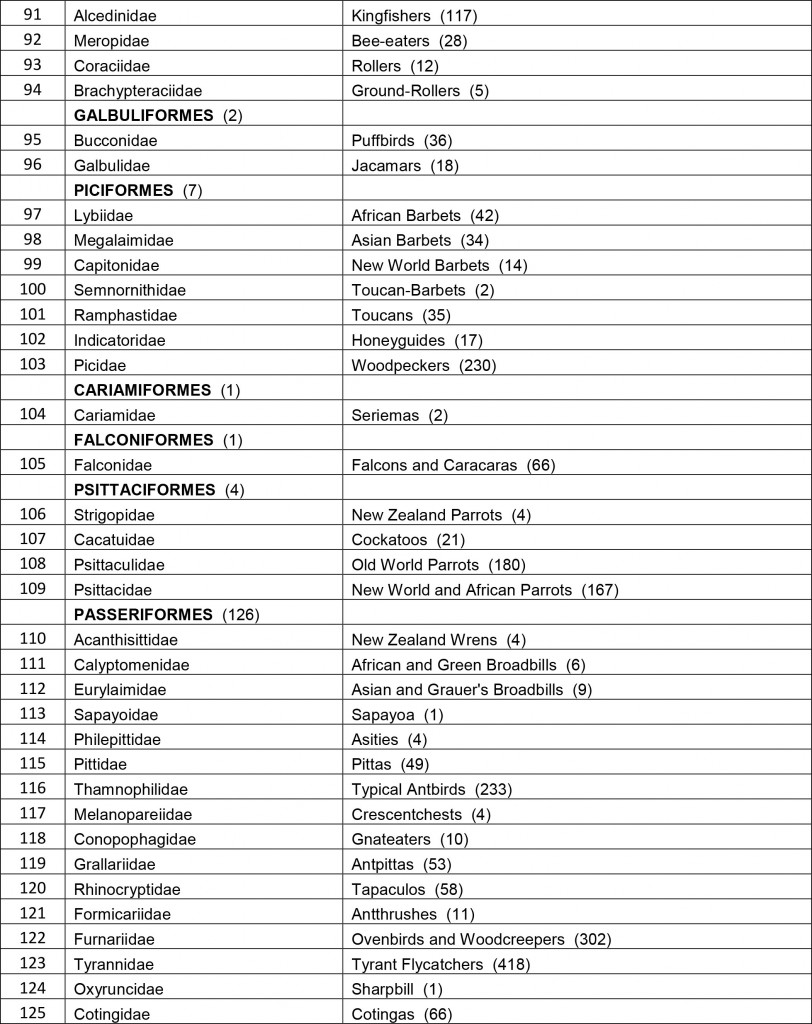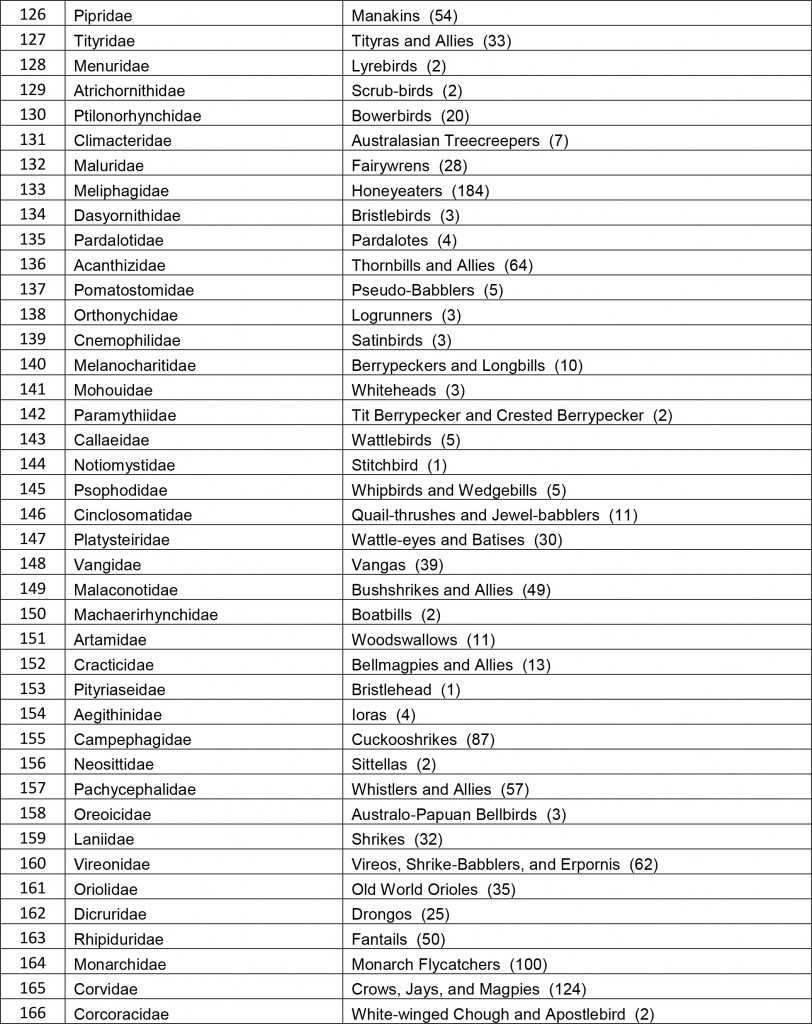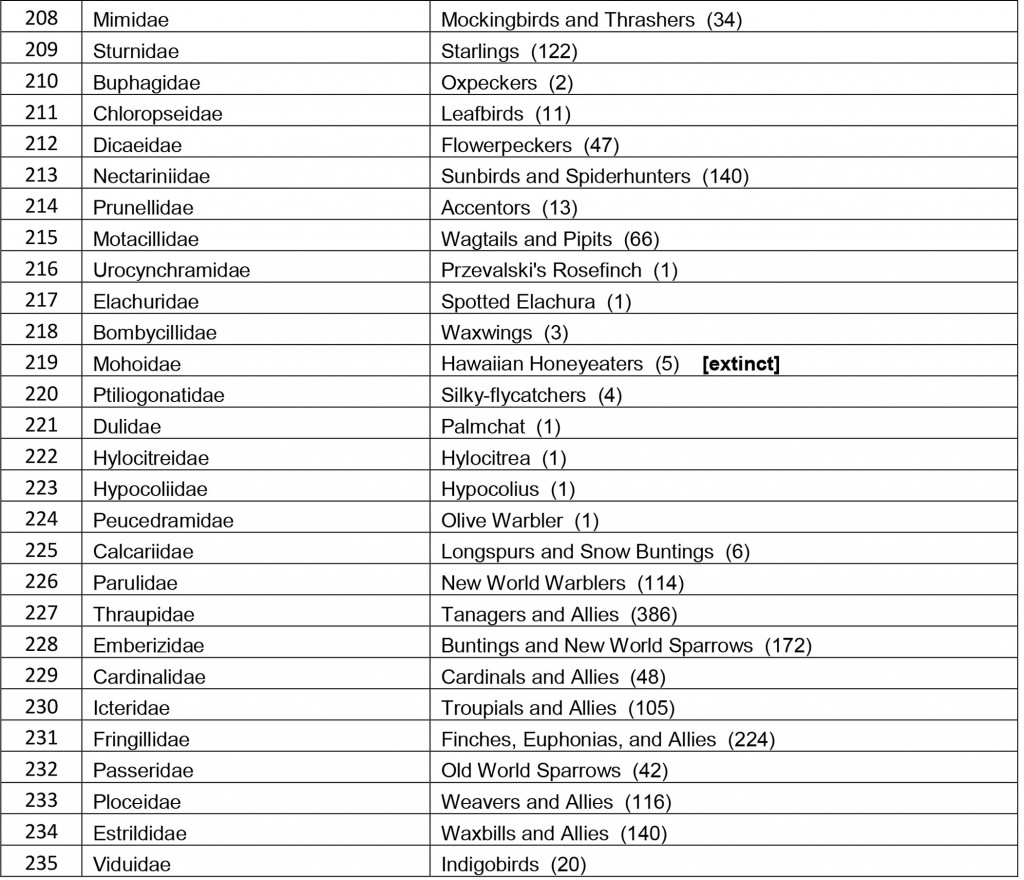August 2015
Overview
Go directly to 2015 Updates & Corrections
This is the tenth installment of Updates and Corrections following the publication (2007) of the sixth edition of The Clements Checklist of Birds of the World; because the Clements Checklist is tightly interwoven with the taxonomy for eBird, the checklist now is referred to as the eBird/Clements Checklist. The entire checklist (including the 2015 Updates and Corrections) is available as a downloadable spreadsheet (in Excel and .csv formats). This year’s spreadsheet version is eBird/Clements Checklist v2015, and will be released on 10 August 2015.
The spreadsheet contains 14 fields (data columns):
sort v2015 – reflects the sequence of species, groups, and subspecies in eBird/Clements v2015
Clements v2015 change – a brief note to signal that a change from Clements Checklist 6.9 occurred for that entry. Sometimes only a single change is made per entry; sometimes several changes are made, although only one or two may be noted in the spreadsheet. In all cases, please consult the Updates and Corrections – August 2015 page for a full explanation of these changes.
Text for website v2015 – a brief explanation of the change from Clements Checklist 6.9 occurred for that entry. Please consult the Updates and Corrections page for a more complete explanation of these changes.
Category – reflecting whether the entry on that line is a species; a subspecies; a monotypic group (i.e., a group that is equivalent to a single subspecies); or a polytypic group (a group composed of two or more subspecies). Thus, the total number of subspecies recognized in the eBird/Clements Checklist is the sum of all entries listed as “subspecies” and as “group (monotypic).”
English name
Scientific name
Range
Order
Family
Extinct – an entry in this column means that the species or subspecies is extinct
Extinct year – reflects the year the species or subspecies went extinct (or, since the extinction date rarely is known with certainty, the last year in which it was reported); “xxxx” is used when the date of extinction was not readily accessible.
Sort 6.9 – reflecting the sequence of species in Clements Checklist 6.9
Sort 6.8 – reflecting the sequence of species in Clements Checklist 6.8
Page 6.0 – reflecting the page number of the species in the last (sixth) print edition (2007)
Here is a brief review of the changes that are introduced in the eBird/Clements Checklist v2015:
SUMMARY STATISTICS
Species 10473
Subspecies 20697
Groups 3013
Families 234 (with 1 additional, extinct, family)
SPECIES
In this year’s updates, we have a net gain from three new species, that is, species for which there was no entry at all in the previous edition of the eBird/Clements Checklist. These three represent species that only recently were described to science, one from perennial powerhouse South America, and two from tropical Asia. An additional newly described species, from the Western Palearctic, also is included in the checklist; due to a tricky nomenclatural situation, however, this newly described species does not result in a net increase in the overall tally. Another 73 species are newly recognized in the eBird/Clements Checklist due to “splits.” There also is a loss of 7 species due to “lumps.”
As before, we update the taxonomy and nomenclature of species for North America, based on decisions of the North American Checklist Committee (NACC), through the Fifty-sixth supplement to the American Ornithologists’ Union Check-list of North American Birds (July 2015). We also are current with decisions of the South American Classification Committee (SACC) through 8 July 2015.
GROUPS
eBird/Clements Checklist has adopted the concept of the group, which initially was developed by for eBird, a free, global online system to manage your bird records and bird lists. A “group” is a distinctive (field identifiable) subspecies or group of subspecies. The group is not a formal taxonomic unit, but often represents a potential future split (and so groups are a valuable taxonomic tool for the savvy birder).
Groups first were added to Clements Checklist in December 2009 (Clements Checklist 6.5). In the eBird/Clements Checklist v2015, we add 263 new groups.
Some of our attempts at arranging subspecies into groups are incomplete: one or more distinctive subspecies have been identified as groups, but the remaining subspecies have been left “hanging” – they do not belong to any of the groups we have created in that species, but we have yet to form one or more new groups to accommodate them. These “hanging” subspecies now are highlighted in two ways: 1) the sequence of subspecies and naming of the groups within the species always make it clear that these are not included in a group (i.e., they follow a monotypic group or the species as a whole, so are clearly not a component of any groups listed above; and 2) in the spreadsheet we have color coded these “hanging” subspecies in gray to further clarify that their status with respect to groups remains unresolved.
Species with partially formulated (“hanging”) groups are the following:
- Common Tern Sterna hirundo
- Burrowing Owl Athene cunicularia
- Streak-chested Antpitta Hylopezus perspicillatus
- Buff-throated Foliage-gleaner Automolus ochrolaemus
- Dusky-capped Flycatcher Myiarchus tuberculifer
- Goldcrest Regulus regulus
- Tropical Parula Setophaga pitiayumi
- Golden Tanager Tangara arthus
- Bananaquit Coereba flaveola
- Grasshopper Sparrow Ammodramus savannarum
- Red Crossbill Loxia curvirostra
We welcome any help in assigning these “hanging subspecies” to groups, especially if it can be supported by published references.
HIGHER LEVEL TAXONOMY
Two new orders are added (Leptosomiformes and Bucerotiformes), for a total of 39 extant orders. No new families are recognized this year. Consequently the total number of extant families in the eBird/Clements Checklist remains at 234, with an additional extinct family included as well.
The 234 extant families accepted by Clements Checklist are listed below, with the names of orders in bold CAPITAL lettering, and with an additional extinct family listed in brackets. We also provide the number of families in each order (in parentheses, after the name of each order), and the number of species in each family (in parentheses, after the name of each family).
FUTURE UPDATES
The next annual revision that incorporates revisions to the taxonomy and nomenclature of the eBird/Clements Checklist will be released in August 2016.
ACKNOWLEDGEMENTS
Please continue to report potential errors, corrections and suggestions for improvement to eBird/Clements Checklist (please send taxonomic changes, suggestions, or questions to cornellbirds@cornell.edu). Many of the errors that you find are ones that would have taken a long time to notice, so we appreciate your help, and we do want to hear from you. Please keep in mind, of course, that the easiest corrections or proposed revisions are the ones that are accompanied by a supporting reference or citation.
Denis Lepage, who runs Avibase, carefully reviewed our files, made useful comparisons with other taxonomies, pointed out errors, and helped with many taxonomic issues through this process; we are extremely grateful for his generous assistance. Peter Kovalik, Frank Gill, David Donsker, Vitor Piacentini, and Alex Lees also have gone out of their way to provide helpful suggestions. We take full responsibility, of course, for any remaining errors. We also are grateful to Bruce Beehler, Terry Chesser, Thane Pratt, and George Sangster for providing advance copies of works in progress.
We also thank the following for their help in providing helpful comments on the eBird/Clements Checklist or for directing us to important literature for our consideration:
Margaret and Richard Alcorn, Desmond Allen, Mike Andersen, Nick Anich, Josh and Kathi Beck, David Bell, Louis Bevier, David Bishop, Jerry Blinn, Kerem Ali Boyla, Ron Braun, Ken Burton, Dick Cannings, Fabricio Carlos Gorleri, Geoff Carpentier, Peter Chalmers, Paul Clapham, Mich Coker, Jacob C. Cooper, Mario D’Angelo, Ian Davies, Andrew Dreelin, Pete Dunten, Mark Eaton, Roger Evans, Bruce Fall, Shawneen Finnegan, Kimball Garrett, Mat Gilfedder, Doug Gochfeld, Héctor Gómez de Silva, Peter and Sandra Greaves, Alan Grenon, Mary Gustafson, Lauren Harter, Peter Hosner, Rich Hoyer, David Irons, Praveen J, Jesper Bay Jacobsen, Alvaro Jaramillo, Oliver Komar, Peter Kovalik, Niels Larsen, Jack Levene, Tony Leukering, David Levasheff, Dali Lin, Barbara MacKinnon de Montes, Matt Medler, Glenn Mertz, Steven Mlodinow, Joe Morlan, Mark O’Brien, Ryan O’Donnell, Scott Olmstead, Tommy Pedersen, Christian Perez, Yoav Perlman, Manuel Plenge, Bill Pranty, Suhel Quader, Gregg Recer, Martin Reid, Colin Richardson, Steve Rose, Dave Sargeant, Fabrice Schmitt, Jacob Socolar, Roger Staples, Zheljko Stanimirovic, David Vander Pluym, Wich’yanan Limparungpatthanakij, and Douglas R. Wood.
As well as the wider community of eBird users, the always astute members of the Taxonomy and Nomenclature group on BirdForum, and no doubt others who we may have inadvertently overlooked.
Thanks to all for your support, and we look forward to your feedback.
Thomas S. Schulenberg (Avian Taxonomist); Marshall J. Iliff, Brian L. Sullivan, and Christopher L. Wood (eBird Project Leaders); Thomas A. Fredericks (eBird Database Administrator); and Don Roberson.

